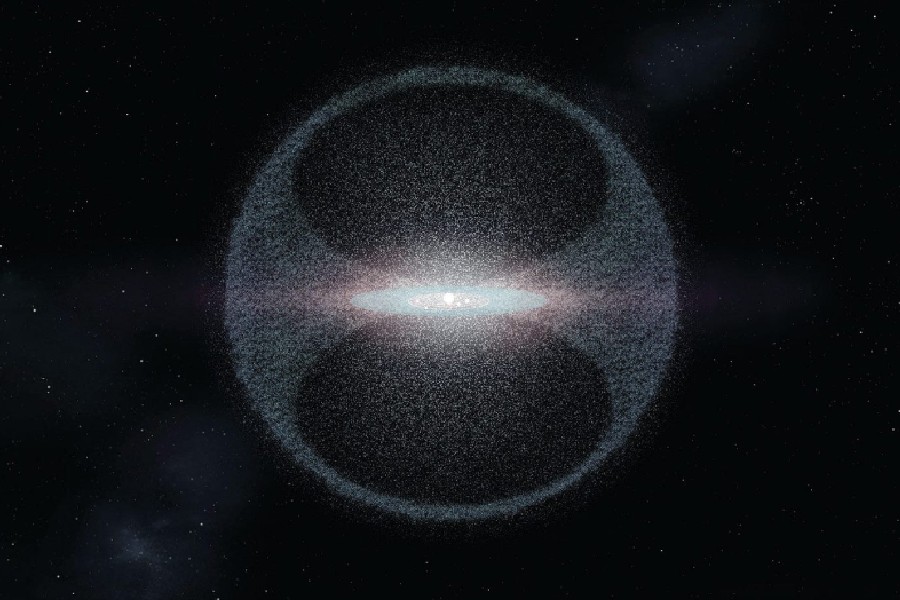Looking up at the night sky, do you ever wonder what exists beyond the farthest planets and stars you can see? There lies a mysterious region at the very edge of our Solar System known as the Oort cloud.
The Oort cloud is thought to surround our Sun and the rest of the Solar System like a thick spherical shell.
In this article, we will explore the intriguing question – how big is the Oort cloud? While we can’t directly observe it, scientists have developed theories about its size based on mathematical models and scientific principles. Getting a handle on just how large this enigmatic cloud is could tell us a lot about the origins and extent of our cosmic neighborhood.
Join us on a journey to the outer limits of our Solar System as we investigate one of space’s enduring mysteries.

How Big Is the Oort Cloud?
How big is the Oort cloud? The Oort cloud is a vast region of space surrounding our solar system. It’s believed to extend far beyond the orbits of Pluto and the other dwarf planets.
While its exact size isn’t precisely known, it’s estimated to stretch about 1-3 light-years from the Sun. This means it spans an incredibly large distance, containing billions or even trillions of icy objects such as comets and icy debris left over from the formation of the Solar System.
Understanding the Size and Distance of the Oort Cloud
Overview of the Oort cloud’s vastness
The Oort cloud is astonishingly vast and remote, even by astronomical standards. This hypothesized spherical shell of icy bodies surrounds our Sun at the very fringes of our solar system.
The inner edge of the Oort cloud is estimated to begin somewhere between 2,000 and 5,000 astronomical units (AU) from the Sun. For reference, 1 AU is the average distance between the Earth and the Sun, about 93 million miles. So at a minimum, the Oort cloud starts over two trillion miles away.
The outer extent of the cloud is even more mind-boggling, potentially reaching out an incredible 50,000 to 100,000 AU from the Sun. At these barely fathomable distances, the Oort cloud objects are so far away that the Sun appears merely as an insignificant dot.
Estimated boundaries and spatial relationship to the Sun
The cloud’s incredible dimensions emphasize just how tiny our neighborhood is compared to the enormity enclosing our solar system’s planetary realm. The remote denizens of the Oort cloud have remained unseen. They provide the theoretical source for visiting long-period comets. These comets arrive from the deep freeze of the outermost Solar System.
Estimates of Size and Distance
Numerical estimates based on models
Given its vast distance, the Oort cloud remains unobserved directly. However, theoretical models provide estimates for its potential size and extent based on gravitational dynamics. The inner edge is predicted to begin around 2,000 to 5,000 AU from the Sun. While the outer boundary may reach 50,000 to 100,000 AU away.
This creates an extremely diffuse, spherical shell thousands of times wider than Pluto’s orbit. The estimated radii differ somewhat based on the formation models used. Regardless, it is clear the Oort cloud occupies an incredibly large volume, even for interplanetary standards.
Observational constraints
While we cannot see the Oort cloud objects yet, observations of long-period comets provide clues about the cloud’s size and distance. Analyzing the trajectories and origins of these comets helps confirm the vast reservoir required to supply them.
Disruptions like passing stars can send Oort cloud members into the inner Solar System, as the observed long-period comets. The cloud must be huge and distant to account for their timing and arrival directions. Ongoing comet studies continue to corroborate theoretical size estimates for our solar system’s distant, icy outer shell.
Comparing the Oort Cloud With Other Planetary Regions
Contrasting the Oort cloud, Kuiper belt, and asteroid belt
The Oort cloud occupies a truly immense volume compared to other known structures in our solar system. The Kuiper belt exists closer in, beginning just past Neptune’s orbit around 30 AU from the Sun and extending to about 55 AU away.
This donut-shaped ring harbors many small icy bodies but spans a tiny fraction of the Oort cloud’s spatial extent. Even more compactly, the asteroid belt contains millions of rocky objects orbiting between Mars and Jupiter, at only about 2-3 AU from the Sun.
Signifying the Solar System’s outer limits
The remoteness and spread of the Oort cloud signify its practical outer boundary. This boundary marks the extent of our Sun’s gravitational dominance and planetary realm. Beyond the hypothesized Oort cloud, interstellar space and other stars hold sway.
While a few long-period comets arrive from its depths, the cloud’s contents remain invisible for now. The Oort cloud’s theorized extent stretches the imagination and marks the Solar System’s known periphery.

Context Within Interplanetary and Interstellar Space
The Oort cloud’s place in interplanetary space
The Oort cloud occupies a unique position in the space between planets in our solar system. It represents the distant, spherical outer shell enclosing all the Sun’s planetary realm out to many thousands of AU.
Beyond the orbit of planets like Neptune and Pluto, the Oort cloud may be the last holdout of our star’s influence before interstellar space. The cloud demarcates the transition between interplanetary space dominated by our Sun and interstellar space between stars.
Contrast to molecular clouds and deep space
Molecular clouds, the stellar nurseries where stars form, span hundreds of light years and dwarf even the Oort cloud’s scales. Between the clouds are the vast expanses of largely empty interstellar space.
The Oort cloud, while incredibly remote by Solar System standards, is just a tiny bubble in enormity. It signifies a little pocket of our Sun’s realm amidst the grander web of stars, clouds, and galaxies. The cloud contextualizes the minuscule domain our star holds relative to the deeper cosmos.
Composition of Objects Within the Oort Cloud
The Oort cloud is very far from the Sun and it is a very cold place. Most things in the Oort cloud are made of ice. There are icy comets, icy asteroids, and other frozen objects. Some even may have liquid water oceans inside despite the cold.
Scientists believe about 90% of the stuff in the Oort cloud is icy. There are also some rocky asteroids and dormant comets, but even they have ice inside. Models show there may be over a trillion icy comets in the Oort cloud.
Icy bodies, comets, and short-period comets
The outer Solar System has many icy bodies. They’re made of frozen gasses, ice, and dust. Some examples of icy bodies include comets, icy asteroids, and Kuiper belt objects. Lots of icy stuff formed past the “snow line“, where materials freeze solid. Over time, these icy chunks collided and stuck together into bigger objects. They stayed frozen in the cold.
Most comets started as icy bodies long ago. These frozen objects have old materials from when the Solar System formed. Models show the Kuiper belt supplied many short-period comets.
As things interact out there, they can get tossed inward. Then Jupiter’s gravity can lock them into short orbits that repeat more often. They shed ice and gas when they get close to the Sun. So today’s short-period comets likely began as tiny icy bodies beyond Neptune billions of years back. Gravitational kicks moved some to the inner Solar System.
Comparing with Kuiper belt objects and Jupiter-family comets
Differences in object characteristics
Oort cloud objects reside in a spherical halo encompassing the outer Solar System. Being so distant, they remain extremely cold and icy. Kuiper belt objects also contain ice, but some are large enough to be warm internally.
Orbiting closer inward, Jupiter comets from the Kuiper belt are exposed to higher temperatures than Oort cloud comets. Unlike the spherical Oort cloud, Kuiper belt objects occupy a flatter disc orbiting the Sun amidst planets. Hence, the orbits of Kuiper belt objects tend to be more stable than those of the diffuse Oort cloud objects.
Oort cloud objects orbit in a sphere around the whole region. Their orbits are less stable than Kuiper belt orbits. Jupiter comets have short orbits of less than 20 years. Oort cloud comets take much longer to orbit. Some take over 100,000 years to orbit once! Their orbits are very stretched out compared to Jupiter comets.
Comparing Oort cloud, Kuiper belt, and Jupiter comets
Oort cloud members mostly seem to be icy comets. Models predict about 90% of Oort objects are icy bodies. The Kuiper belt has more variety, like dwarf planets, asteroids, icy worlds, and comets. Jupiter comets originate from the Kuiper belt. They get tossed inward and locked into fast orbits.
Oort cloud comets scarcely interact with planets, only falling into the inner Solar System infrequently from their distant and isolated domain. Despite sharing common cometary origins, each remains distinct in nature.
Among these icy clans spanning vast distances, Oort cloud bodies stay the coldest and most removed, like solitary icicles stored in the farthest cosmic reaches, seldom disturbed.
Kuiper belt has more residents and is closer-knit and diverse. While Jupiter comets race around at breakneck orbital speeds close to home, the differences shed light across our cosmic history.
Conclusion
After exploring the mysteries surrounding how big is the Oort cloud, we have gained a better understanding of the true scale of our Solar System. While the enormous size of the Oort cloud means we may never fully map its outer limits, astronomers continue refining their estimates with new observations and insights.
We hope you now appreciate just how tiny our neighborhood is compared to the unimaginably vast reaches of space beyond. The journeys of discovery into the outer Solar System teach us humility and wonder in the face of a universe filled with unanswered questions.
This article has illuminated the immensity of the cosmos as we ponder one of its farthest frontiers right here in our galactic backyard.
